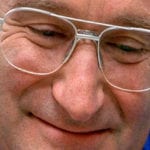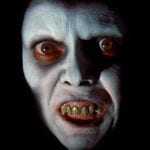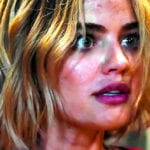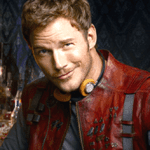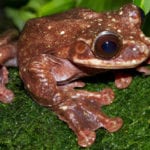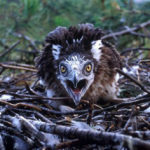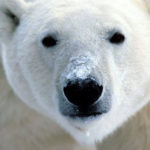 Mysteries
Mysteries  Mysteries
Mysteries  History
History 10 Surprising Stories About the Texas Rangers
 Humans
Humans 10 Philosophers Who Were Driven Mad by Their Own Theories
 Miscellaneous
Miscellaneous 10 Video-Game-Worthy Weapons and Armors from History
 Weird Stuff
Weird Stuff 10 Psychics Who Accurately Predicted Wartime Events
 The Arts
The Arts 10 Pieces of Art Inspired by a Broken Heart
 Health
Health 10 Science Fiction-Sounding New Medical Treatments
 History
History 10 Surprising Facts About the Father of Submarine Warfare
 Space
Space Ten Astonishing New Insights into Alien Worlds
 Weird Stuff
Weird Stuff 10 Bizarre Summer Solstice Rituals Still Practiced Today
 Mysteries
Mysteries Top 10 Haunting Facts About the Ghost Ship MV Alta
 History
History 10 Surprising Stories About the Texas Rangers
 Humans
Humans 10 Philosophers Who Were Driven Mad by Their Own Theories
Who's Behind Listverse?

Jamie Frater
Head Editor
Jamie founded Listverse due to an insatiable desire to share fascinating, obscure, and bizarre facts. He has been a guest speaker on numerous national radio and television stations and is a five time published author.
More About Us Miscellaneous
Miscellaneous 10 Video-Game-Worthy Weapons and Armors from History
 Weird Stuff
Weird Stuff 10 Psychics Who Accurately Predicted Wartime Events
 The Arts
The Arts 10 Pieces of Art Inspired by a Broken Heart
 Health
Health 10 Science Fiction-Sounding New Medical Treatments
 History
History 10 Surprising Facts About the Father of Submarine Warfare
 Space
Space Ten Astonishing New Insights into Alien Worlds
 Weird Stuff
Weird Stuff 10 Bizarre Summer Solstice Rituals Still Practiced Today
Top 10 Animal Actors
Movies and television seem to have a never-ending supply of talking, dancing and singing animals. Often their performances are enhanced by computer graphics or robot doubles. While there is nothing wrong with that, before CGI, there were a number of animals that performed in front of the cameras with only the promise of a bone at the end of the day. On this list, our performers are free from CGI and animatronics. On television in the Fifties, Sixties and Seventies, many animals had their own television shows. If your favorite isn’t on this list, let me apologize now, and wait for the honorable mentions.
Names for these animal thespians can be confusing as many were billed not by their given names but by the role they played, or not billed at all.
The top five animal actors on this list are all dogs. These dogs all gave performances that many times went beyond doing tricks. The top dog on this list could shame Keanu Reeves, Matthew McConaughey, and many other A-list actors.
A tip of the hat must go to Frank Weatherwax, his better known brother Rudd, and Frank Inn. Together and separately, they trained many animals from at least the Thirties into the Eighties. Frank Inn started as an assistant to the Weatherwax brothers and later struck out on his own, training the animals for The Beverley Hillbillies, Petticoat Junction and Green Acres. Rudd Weatherwax is known to millions for his dog food endorsements with Lassie. These trainers are mentioned in this list more than once.
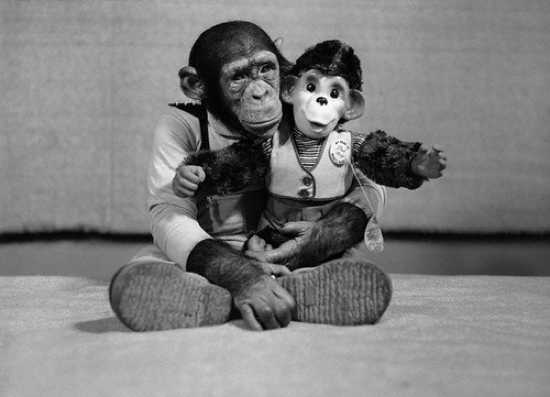
NBC Television had launched The Today Show with Dave Garroway. Ratings were dreadful, until someone got the idea of adding a chimpanzee as a mascot. Ratings for the show improved dramatically, and television sales increased as well. J Fred didn’t do tricks, didn’t read the weather forecast, or laugh at Garroway’s jokes. He was, like many actors and artists, somewhat temperamental, but kept his job because he was ratings gold. He had at least one guest starring role as an actor on the television program, Tom Corbett Space Cadet. He was born in 1952 and first appeared on the Today show, wearing diapers, in 1953. In addition to his television work, J Fred Muggs is a painter, and created a cover for June 1960 issue of Mad magazine. I could not find an obituary for J Fred, and I have references to his living in Florida in 2004. This would make him the only living member of this list. When The Today Show had its 50th anniversary program, J. Fred was not invited.
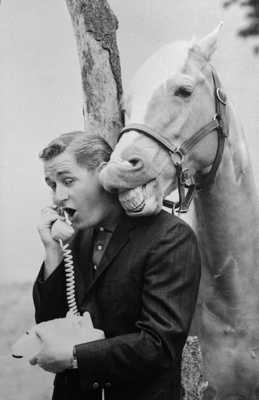
Bamboo Harvester was the star, along with Alan Young, of the television program Mr. Ed. On the program he was not credited under his own name, but as the title character, “Mr. Ed.” Bamboo was trained by Les Hilton, who had also worked on the Francis The Talking Mule movie series of the 1950s, training the mule, whose actual name was Molly. Bamboo Harvester and Molly appeared to talk by having a nylon thread placed in their mouths which, when pulled by Hilton, made the animal move his lips. Bamboo was picked for the role of Mr. Ed as he was not temperamental and could work with the string in his mouth for hours without complaint. The reason Bamboo makes this list and not Molly is that, according to both Hilton and series star Alan Young, Bamboo eventually figured out that he was supposed to move his lips when Young stopped talking, and the thread was no longer needed. The thread can be seen in early episodes of the program, but not in later ones, bearing this out. When interviewed during the show’s production, Young stated the effect was achieved by putting peanut butter on the horse’s gums, but this story was used to keep the real method secret. Mr. Ed’s voice was supplied, unaccredited, by former cowboy star Allan “Rocky” Lane.
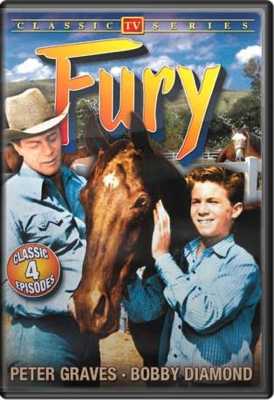
Highland Dale was the black stallion who starred in Black Beauty, in 1946. Born in 1943 in Missouri, Highland Dale acted from the 1940s until the 1960s, in both movies and television roles. Trained by Ralph McCutcheon to untie knots, play dead and whinny on command, Highland Dale later starred on the television show, Fury, with Peter Graves and Bobby Diamond. Highland Dale’s last credited appearance was guest staring on an episode of Lassie. Highland Dale passed away of respiratory problems in 1972.
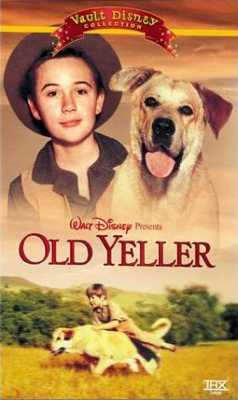
Spike, a yellow Labrador, portrayed Old Yeller in the Disney movie of the same name. If you haven’t seen the film, have a hanky nearby. He was rescued from an animal shelter by Frank Weatherwax. In addition to Old Yeller he appeared in the movies A Dog of Flanders, The She-Creature and The Silent Call. He made television appearances as well, including an episode of The Mickey Mouse Club.

Golden Cloud appeared in movies before being purchased by Roy Rogers and renamed Trigger. Many movie cowboys had a trained horse, Tom Mix had Tony, William Hart had Fritz and Gene Autry rode more than one horse named Champion. These horses did jumping and riding tricks, but Trigger could take direction, and performed over a hundred tricks, such as untying Roy’s hands, walking on his hind legs, dancing and playing dead, all by voice command. His most incredible trick was that he was housebroken, which enabled Roy to take him in theaters and television studios. Trigger even had his own Dell comic book for a time. Trigger was stuffed after his passing and is now apparently owned by the cable channel Rural Free Delivery Television, which is opening a western museum.
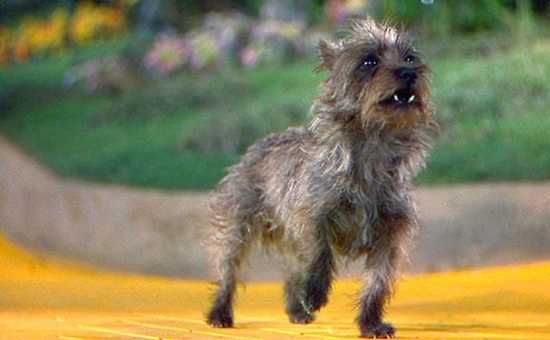
Terry was a terrier who is most famous for playing Toto in The Wizard of Oz. She worked in over a dozen other films including Bright Eyes with Shirley Temple, and her last movie, Tortilla Flat with Spencer Tracy and Hedy Lamar. Terry was seldom credited under her real name and in Oz is credited as Toto. It was while working on Oz that Terry’s foot was broken by an actor playing one of the Wicked Witches soldiers. Terry recovered, and made many films afterward. An “autobiography” of Terry was released and occasionally is available at Amazon.

Pal was working as a stunt dog on the 1943 MGM movie Lassie Comes Home, with child stars Roddy McDowell and Elizabeth Taylor. Pal had lost the title role to a prized female show collie, however during production Pal was selected as the lead. There are conflicting accounts as to why this happened, but Pal proved to be a one-take wonder and starred in seven movies for MGM. Pal was owned and trained by Rudd Weatherwax, with assistance from his brother Frank, and later Frank Inn. When MGM stopped making Lassie films, they still owed Rudd money and he accepted the rights to the Lassie character, in lieu of payment. He took the Lassie character to television for a series that ran from 1954 until 1973. Though Pal’s son (named Lassie Jr.) had taken over his role in the movie series a few years before, Pal took the Lassie role one more time for the pilot episode, and apparently was present in the studio while his progeny worked the role. He was used as the occasional backup. Pal passed away in 1958.
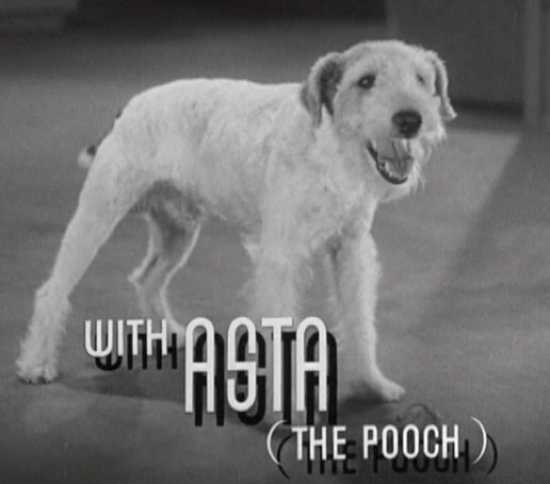
Skippy was a wire-haired terrier trained by original owners Henry and Gale East, with assistance from the Weatherwax brothers and Frank Inn. Skippy is best known from his role as Asta in the first two Thin Man Movies with Myrna Loy and William Powell. He was billed as Asta in those movies and look-alike dogs appeared later in the Thin Man series billed under that name. Skippy also appeared in many films, both before and after The Thin Man. He was an “extra” in some films and featured in others. A couple of his prominent roles, besides Asta, were as Mr. Smith the dog in The Awful Truth and as George in Bringing Up Baby, both with Cary Grant. Skippy suffered from inconsistent billing in his time, sometimes being credited as Skippy, Asta or not at all. After Skippy passed away, other terriers were credited as Asta. Skippy shows a good acting range in his movies, acting afraid, mad or doing an impersonation of a bloodhound.
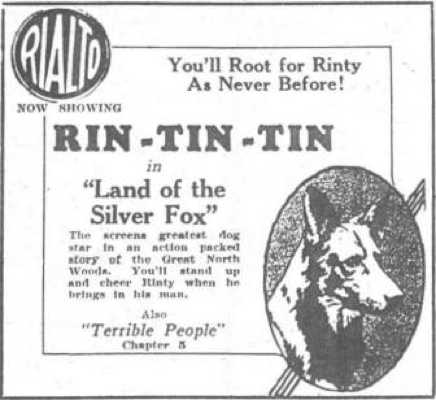
The original Rin Tin Tin was a dark German Shepard owned and trained by a World War One veteran from Los Angeles, Lee Duncan. He brought the dog back from France after the war, training him to do tricks. He hoped Rin Tin Tin would follow in the footsteps of previous celebrity movie canines, Jean The Biograph Dog and Strongheart. The dog found work playing wolves in early features. Rin Tin Tin became hugely popular in the 1920s and 1930s, and his movies were big moneymakers for Warner Brothers, credited with saving the company, financially. The film series helped get Daryl Zanuck promoted to a prominent position within that studio as Zanuck was an early champion of the film series. (Perhaps without these movies, there would be no Time-Warner conglomerate today.) Rin Tin Tin appeared in a series of movies playing “Rinty” (also his real nickname), as well as taking other canine roles, such as “Scotty” in Tiger Rose in 1931. By 1930, he had his own radio program on the NBC Blue network. The radio reference book “The Big Broadcast” by Buxton and Owen references Francis X. Bushman as his co-star on that program. Rin Tin Tin played himself, barking and growling on cue. In 1932, Rin Tin Tin passed away. There had already been a transition to his son, Rin Tin Tin Jr., both on the radio show and in the movies. There have been many Rin Tin Tins since the original, all from the original bloodline. The original Rin Tin Tin has a star on the Hollywood Walk of Fame. The 1976 film comedy, Won Ton Ton: The Dog Who Saved Hollywood is a spoof on the Rin Tin Tin craze.
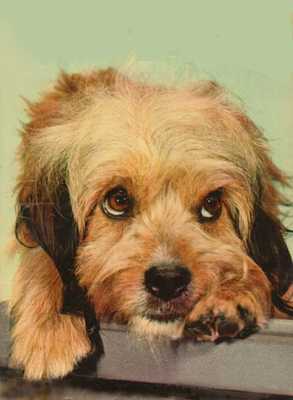
Higgins was the Tom Hanks of animal actors, with an acting range wider than that of many human professionals. He is best known for playing the title role in Benji. He had a regular role on the C.B.S. television comedy Petticoat Junction as Dog, and appeared in other movies and television programs. He was trained by Frank Inn, who also trained the animals on The Beverly Hillbillies and Green Acres. Like many actors, Higgins started from humble beginnings, a mixed breed in an animal shelter. Frank Inn considered Higgins his best pupil. Although Higgins could do over a hundred tricks, he was much more than a well-trained dog. He also could show emotions on cue, acting afraid, interested, sad or bored as needed. He could sneeze or yawn on cue. He could do romantic comedy, or go full-tilt Rambo as required. The original Benji film (subsequent movies used other dogs) was not his only starring role, he also was the star of Mooch Goes To Hollywood, with Zsa Zsa Gabor and Vincent Price as his co-stars. Higgins played the title role. While working on Petticoat Junction, he developed a special relationship with co-star Edgar Buchanan and their work together in Benji could be one of the most natural performances by a canine and man on film. The urn with his ashes was buried in the casket of his trainer, Frank Inn.
Notable omissions: Arnold The Pig (he just had great writers and there were many Arnolds), Moose, who played Eddie on television’s Frazier, Manis, from the film Every Which Way But Loose, and Mitzi, the original Flipper from the 1963 film.
